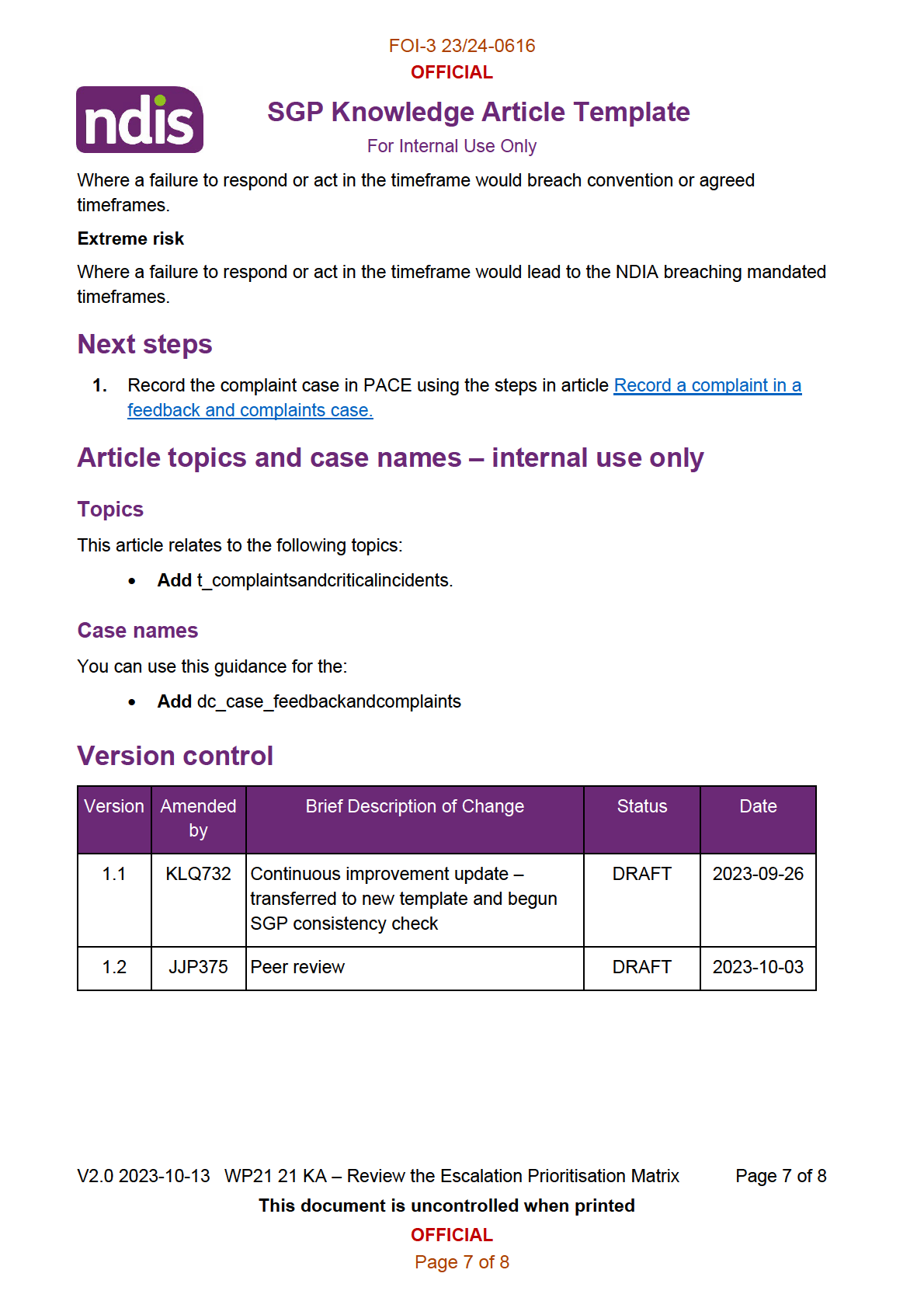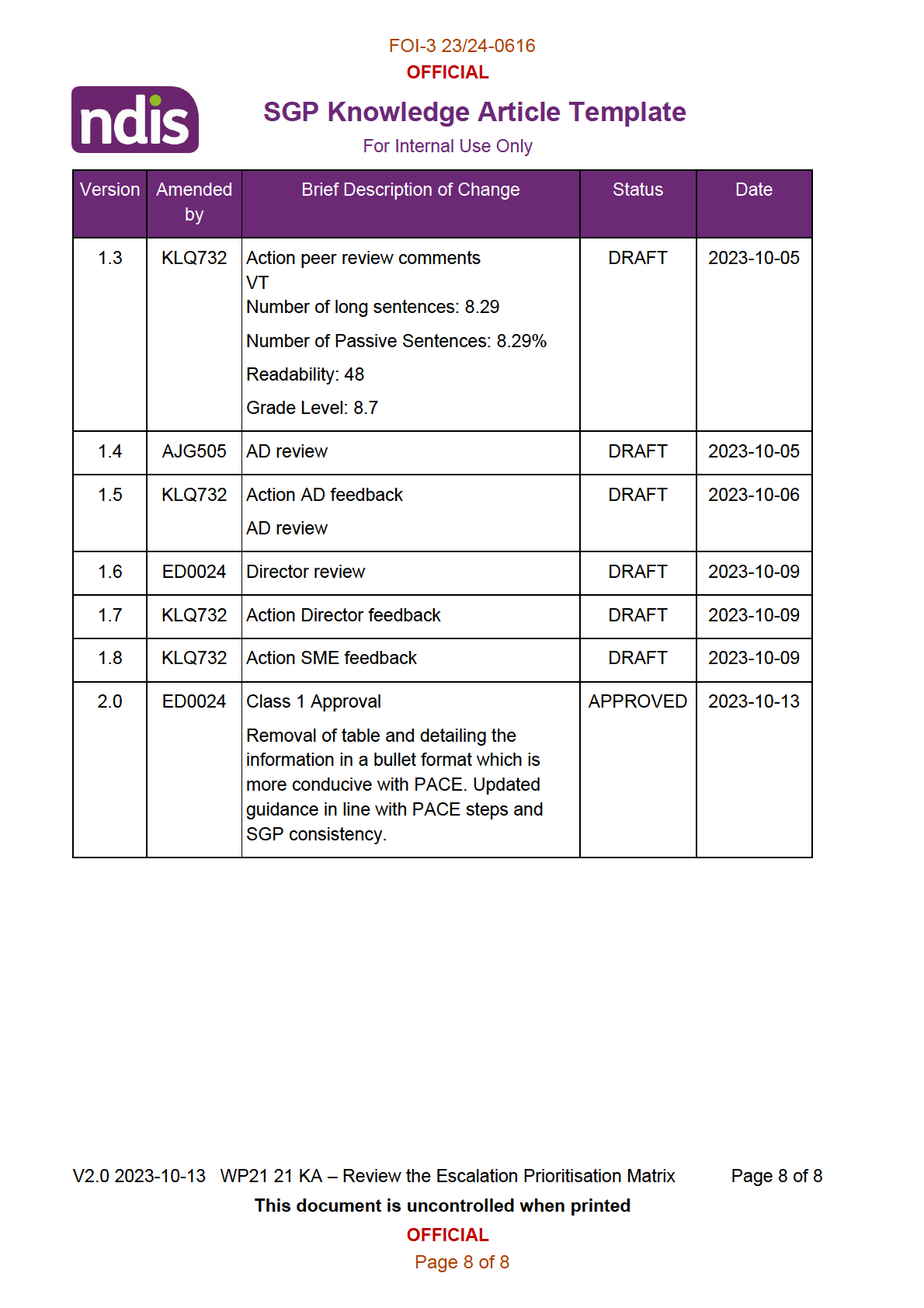 DOCUMENT 1
DOCUMENT 1
FOI-3 23/24-0616
OFFICIAL
SGP Knowledge Article Template
For Internal Use Only
The contents of this document are OFFICIAL.
Review the escalation and prioritisation matrix
This article provides guidance for a
local area coordinator,
early childhood partner and all
NDIA staff (
planner delegate,
payments officer,
internal review delegate,
complaints
officer,
participant support officer,
access delegate,
technical advisors,
National
Contact Centre,
liaison officers (HLO/JLO),
complex support needs (CSN) planner,
national reassessment delegate) to:
• record the risk level and type within PACE
• use the escalation and prioritisation matrix.
Recent updates
October 2023
Current guidance.
Before you start
You have read and understood:
• the NDIS Complaints and Feedback Framework (DOCX 486KB)
• what the Complaints and Participant Incidents Team is responsible for
• article Understand compliments, feedback and complaints
• article Create a feedback and complaints case
Record the risk level and type within PACE
When you create or update a
Feedback and Complaints case, you wil need to assess the
Risk and
Risk Type at the
Complaints Categorisation screen of a
Feedback and
Complaints case.You can assess the
Risk and
Risk Type using the escalation and
prioritisation matrix below.
The
Risk and
Risk Type indicate the required resolution timeframe. Once the case is
submitted, the complaint case wil be routed accordingly. To learn more about how different
complaints levels are routed, go to article Understand compliments, feedback and complaints.
You can record the
Risk and
Risk Type at the
Complaints Categorisation screen in a
Feedback and Complaints case. For more information, go to article Record a complaint in a
feedback and complaints case.
V2.0 2023-10-13 WP21 21 KA – Review the Escalation Prioritisation Matrix
Page 1 of 8
This document is uncontrolled when printed
OFFICIAL
Page 1 of 8

FOI-3 23/24-0616
OFFICIAL
SGP Knowledge Article Template
For Internal Use Only
Use the escalation and prioritisation matrix
The following information wil help you understand the escalation and prioritisation matrix.
There are 10 types of risk you can input within PACE:
• Risk of harm to the health or well-being of a person
• Instability of accommodation arrangements of a person
• Instability in the care arrangements of a person
• Risk associated with the nature of the person's disability
• Risk associated with the availability of supports
• Risk of inaccurate media report is uncorrected
• Risk that the NDIA is seen as unresponsive to stakeholder and participant concerns
• Risk to the Ministers' confidence in the NDIA's responsiveness
• Risk of adverse finding by government stakeholder
• Deterioration of key relationship (Jurisdiction, Ombudsman, court, tribunal).
For each
Risk Type, you wil need to assess the
Risk as low, medium, high or extreme. This
assessment wil help you to determine the timeframe in which you must respond to and
resolve a complaint. For:
•
Low risk, the timeframe for contact or a response is 2 days, and for a resolution is
15 days
•
Medium Risk,
the timeframe for contact or a response is one day, and for a
resolution is 15 days
•
High Risk,
the timeframe for contact or a response is the same day (or as
specified), and for a resolution is 10 days (or as specified)
•
Extreme risk,
the timeframe for contact or a response is 2 hours (or as specified),
and for a resolution is 10 days (or as specified).
For feedback and complaints, you need to understand:
•
Contact is when you make contact with the participant (or their authorised
representative) to talk about and confirm escalation
• A
Response is when you provide an update on the next steps and timeframes to the
complainant. This may or may not be that the matter is finalised or resolved, for
V2.0 2023-10-13 WP21 21 KA – Review the Escalation Prioritisation Matrix
Page 2 of 8
This document is uncontrolled when printed
OFFICIAL
Page 2 of 8

FOI-3 23/24-0616
OFFICIAL
SGP Knowledge Article Template
For Internal Use Only
example Minister or Member of Parliament, Ombudsman, State Ministry. Specified
timeframes apply to Ministerial or Ombudsman responses
• A
Resolution means the matter is either completely finished, the safety risk has
been mitigated or the next steps are clear or in progress.
Risk of harm to the health or well-being of a person
Low risk Absence of support or action is contributing to a general risk of harm.
Medium Risk
Absence of support or action is contributing to a medium-term risk of harm.
High Risk
Absence of support or action is contributing to a short-term risk of harm.
Extreme risk
Absence of support or action is contributing to an immediate risk of harm.
Instability of accommodation arrangements of a person
Low risk The participant has a generalised risk of homelessness or inappropriate housing solution and
the NDIA has a role in working with State services to rectify.
Medium Risk
The participant is at risk of homelessness or inappropriate housing solution in the medium-
term and the NDIA has a role in working with State services to rectify.
High Risk
The participant is at risk of homelessness or inappropriate housing solution in the short-term
and the NDIA has a role in working with State services to rectify.
Extreme risk
The participant is at risk of immediate homelessness and the NDIA has a role in working with
State services to rectify.
Instability in the care arrangements of a person
Low risk
V2.0 2023-10-13 WP21 21 KA – Review the Escalation Prioritisation Matrix
Page 3 of 8
This document is uncontrolled when printed
OFFICIAL
Page 3 of 8

FOI-3 23/24-0616
OFFICIAL
SGP Knowledge Article Template
For Internal Use Only
There is a risk of family or informal care breakdown and support may prevent such a
breakdown.
Medium Risk
Absence of supports is contributing to family or informal care breakdown or such breakdown
could be prevented by timely inclusion of supports.
High Risk
Absence of supports is contributing to family or informal care breakdown or such breakdown
could be prevented by rapid inclusion of supports.
Extreme risk
Absence of supports is contributing to an immediate risk of family or informal care breakdown.
Risk associated with the nature of the person's disability
Low risk Absence or lack of certainty of continuation of supports is likely to contribute to deterioration or
progression.
Medium Risk
Absence or lack of certainty of continuation of supports is contributing to deterioration or
progression of condition.
High Risk
Absence of support is contributing to existing deterioration or progression of condition.
Extreme risk
Absence of support is contributing to existing rapid deterioration or progression of condition.
Risk associated with the availability of supports
Low risk The plan wil expire or funds wil be exhausted within two weeks so that critical supports can’t
be accessed.
Medium Risk
The plan wil expire or funds wil be exhausted within a week so that critical supports can’t be
accessed.
High Risk
The plan is about to expire or funds exhausted so that supports that are immediately needed
can’t be accessed.
V2.0 2023-10-13 WP21 21 KA – Review the Escalation Prioritisation Matrix
Page 4 of 8
This document is uncontrolled when printed
OFFICIAL
Page 4 of 8

FOI-3 23/24-0616
OFFICIAL
SGP Knowledge Article Template
For Internal Use Only
Extreme risk
The plan has expired or funds exhausted so that critical supports that are immediately needed
can’t be accessed.
Risk of inaccurate media report is uncorrected
Low risk Where the NDIA has given an undertaking to contact and resolve in timeframe.
Medium Risk
Where there has been a request from a news outlet with a credible story OR where the NDIA
has given an undertaking to contact and resolve in timeframe.
High Risk
Where there has been a request from a news outlet with broad coverage OR where a potential
story can be prevented by timely intervention by the NDIA.
Extreme risk
Where the Minister or NDIA wil be engaging with the media, or there is a story already with
broad coverage that is building momentum.
Risk that NDIA is seen as unresponsive to stakeholder and participant
concerns
Low risk Where there is the potential for stakeholder tension if the NDIA does not acknowledge in a
timely way.
Medium Risk
Where an issue could potentially gain traction but can be prevented by timely intervention by
the NDIA.
High Risk
Where an issue could potentially gain traction but can be prevented by rapid intervention by
the NDIA.
Extreme risk
Where an issue is currently known and a lack of response from the NDIA wil exacerbate
tension.
Risk to the Ministers' confidence in the NDIA's responsiveness
Low risk
V2.0 2023-10-13 WP21 21 KA – Review the Escalation Prioritisation Matrix
Page 5 of 8
This document is uncontrolled when printed
OFFICIAL
Page 5 of 8

FOI-3 23/24-0616
OFFICIAL
SGP Knowledge Article Template
For Internal Use Only
Where the Minister’s Office (MO), Assistant Minister’s Office (AMO) or Members and Senators
Contact Office (MaSCO) has requested informal or formal advice.
Medium Risk
Where the MO, AMO or MaSCO has requested informal or formal advice having identified
specific sensitivities.
High Risk
Where the MO or AMO have identified specific sensitivities with short timeframes (e.g.
Ministerial meeting).
Extreme risk
Where the MO or AMO have identified specific sensitivities with extreme timeframes (e.g.
Question Time Brief (QBT) or parliamentary or media appearance).
Risk of adverse finding by government stakeholder
Low risk Where a failure to respond or act would affect the NDIA's ability to provide general information
in an effective way.
Medium Risk
Where a failure to respond or act would affect the NDIA's ability to provide pertinent
information in an effective way.
High Risk
Where a failure to respond or act in the timeframe would prevent the NDIA providing critical
information.
Extreme risk
Where a failure to respond or act in the timeframe would lead to the NDIA breaching mandated
timeframes.
Deterioration of key relationship (Jurisdiction, Ombudsman, court, tribunal)
Low risk Where a failure to respond or act would prevent the NDIA effectively engaging with the
stakeholder.
Medium Risk
Where a failure to respond or act would be seen as disrespectful to the role of the stakeholder.
High Risk
V2.0 2023-10-13 WP21 21 KA – Review the Escalation Prioritisation Matrix
Page 6 of 8
This document is uncontrolled when printed
OFFICIAL
Page 6 of 8









